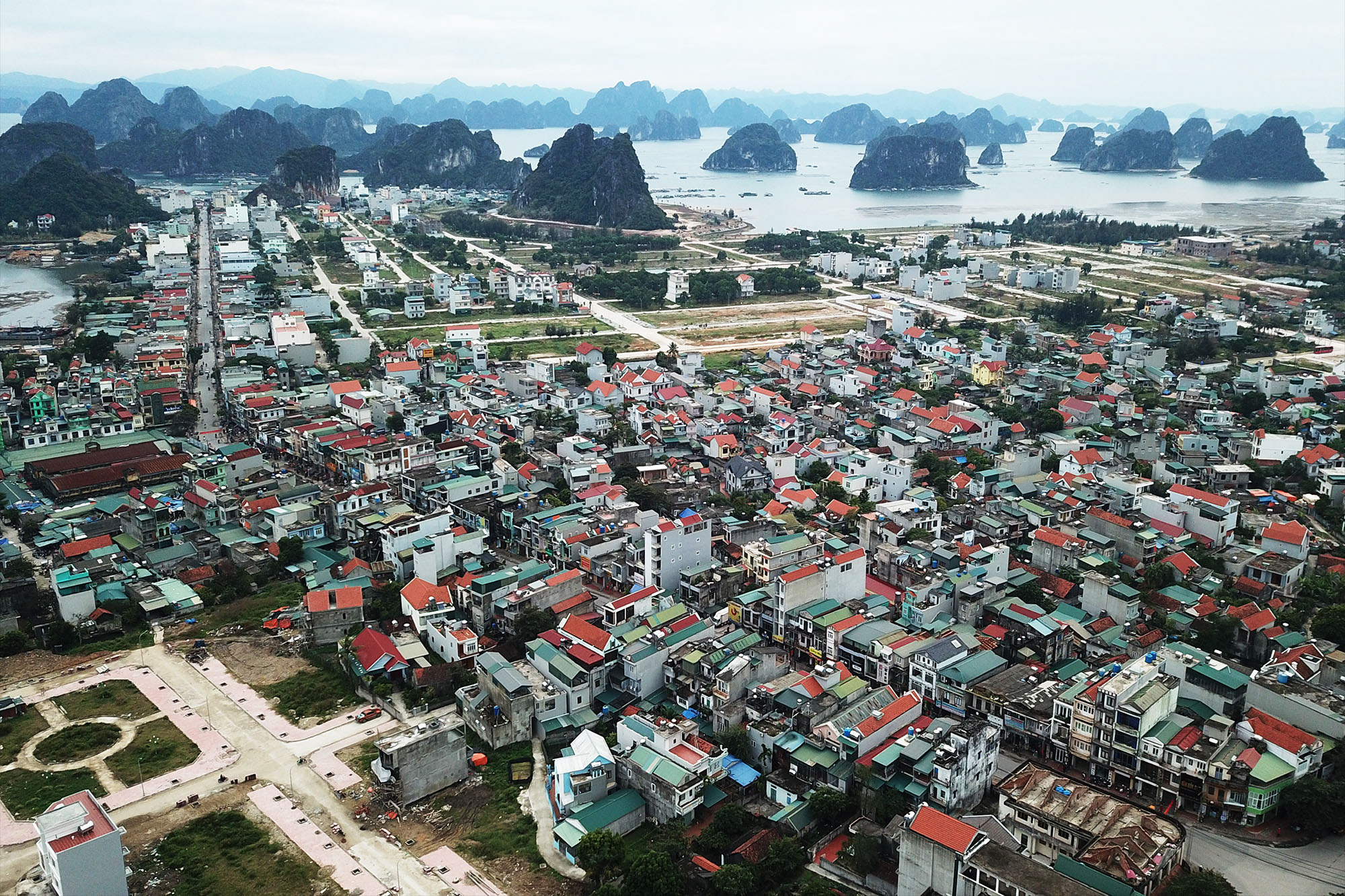
THE INFLUENCE OF URBANIZATION ON AGRICULTURAL LAND USE, EMPLOYMENT, AND INCOME OF RESIDENTS IN VÂN ĐỒN DISTRICT, QUẢNG NINH PROVINCE DURING THE PERIOD OF 2015 – 2021
THE INFLUENCE OF URBANIZATION ON AGRICULTURAL LAND USE, EMPLOYMENT, AND INCOME OF RESIDENTS IN VÂN ĐỒN DISTRICT, QUẢNG NINH PROVINCE DURING THE PERIOD OF 2015 – 2021
Hoàng Hữu Chiến
Nông Quốc Thiên
Nguyễn Quang Thi
Nguyễn Huy Trung
Chu Văn Trung
Nguyễn Ngọc Anh
Dương Minh Ngọc
Nguyễn Duy Hải
Thái Nguyên University of Agriculture and Forestry
Đỗ Quang Tuân
People’s Committee of Minh Châu Commune, Vân Đồn District, Quảng Ninh Province
Abstract:
Urbanization is an inevitable process that occurs in all localities and impacts various aspects of residents’ lives. This study aims to assess the economic and land use structural changes during urbanization and their influences on agricultural land use, employment, and income of residents in Vân Đồn District, Quảng Ninh Province during the period 2015 – 2021.
Vân Đồn District is divided into two research areas. In each research area, 60 household heads were rapidly interviewed about demographics, labor, employment, and land use. The results show that alongside the economic and land use structural changes of the district, the situation of agricultural land use, employment, and residents’ income also significantly changed.
Average agricultural labor decreased from 1.7 to 0.9 workers and from 2.6 to 1.7 workers, while average non-agricultural labor increased from 2.0 to 3.0 workers and from 1.0 to 1.5 workers respectively in regions 1 and 2.
The transition of most household labor from agriculture to non-agricultural sectors has led to an increase in household income from 245.4 to 309.4 million VND/household/year in region 1 and from 160.7 to 245.4 million VND/household/year in region 2. However, a small portion of agricultural land (2,156 m² in region 1 and 2,170 m² in region 2) is being abandoned by residents, which is a matter of concern.
Keywords: Urbanization, Agricultural Land, Vân Đồn District, Employment, and Income.
I. INTRODUCTION
Urbanization is an inevitable social phenomenon that promotes the socio-economic development of nations worldwide (Zagorski, 2012). Economically, urbanization is the process of shifting agricultural activities to non-agricultural activities concentrated in certain suitable areas (Phuong, 2005). From the perspective of population and labor, urbanization is the process of transforming the population structure from agricultural labor to industrial and service labor. Farmers who were previously attached to their fields lose most of their arable land upon becoming urban residents. When shifting to non-agricultural occupations, residents’ income generally increases, but income inequality becomes more pronounced and severe in the context of urbanization (Phuong, 2005).
Vân Đồn District is a center for marine tourism and high-end entertainment services in the Red River Delta region, serving as an international trade hub and a main driver for the development of the Northern Key Economic Region. In recent years, the district has been heavily invested in both technical and social infrastructure to accelerate the formation of the Vân Đồn Economic Zone and Urban Area.
During the construction and development process, land-use conversion is unavoidable. As land is an important internal resource, effective management and utilization of land resources are of special importance to the development of Vân Đồn District.
The objective of this study is to identify the current state of economic and land-use structural changes during urbanization and their impact on employment, income, and agricultural land use of residents in Vân Đồn District, Quảng Ninh Province.
II. RESEARCH METHODOLOGY
- Research Area
The research area encompasses the entire administrative boundary of Vân Đồn District. However, the natural geographical and socio-economic conditions of Vân Đồn District are distinctly divided between the large island area (central region) and the smaller islands. Therefore, the research area is divided into two regions.
Region 1: Comprises 07 communes/townships on Cái Bầu Island and the nearby small islands around Cái Bầu Island in the northwest. This region is part of the smart urban area developed in conjunction with the integrated tourism complex of Vân Đồn District, including the communes of Đông Xá, Hạ Long, Bình Dân, Đoàn Kết, Đài Xuyên, Vạn Yên, and the township of Cái Rồng.
Region 2: Consists of the Vân Hải island chain off the east coast of Bái Tử Long Bay, part of the urban area supporting Vân Đồn port, including the communes of Minh Châu, Quan Lạn, Ngọc Vừng, Bản Sen, and Thắng Lợi.
- Data Collection Methods
Primary data collection method: In the two research regions, a rapid survey and interview of household heads were conducted with the following characteristics:
– Sample size: To support exploratory factor analysis (EFA), with an observation-to-variable ratio of 10:1 for 12 questions, this study surveyed 120 samples across 3 groups (40 samples/group): the group of households with all agricultural land reclaimed, the group of households with part of their agricultural land reclaimed, and the group of households without any agricultural land reclaimed. The methods and results of EFA will be presented in subsequent articles.
– Household heads: Must have full civil capacity and a thorough understanding of the household’s living, production, and business situation.
Secondary data collection method: Data on economic growth indicators, economic structural shifts, and land management and use were collected from the People’s Committee of Vân Đồn District.
- Statistical and Comparison Methods
IBM SPSS 22.0 software was used to perform statistical algorithms, including comparing the mean values of two independent populations (Independent Sample T-Test) and Pearson correlation analysis.
III. RESEARCH RESULTS AND DISCUSSION
- Economic Structural Shifts in Vân Đồn District
From 2015 to 2021, Vân Đồn District experienced a notable economic structural shift, reflected in the fluctuations in the contribution of each sector to the district’s GDP (Table 1).
Table 1. Economic Structure of Vân Đồn District During 2015 – 2021
| 2015 | 2018 | 2021 |
Agriculture | 38.5 % | 36.8 % | 28.1 % |
Industry | 32.0 % | 32.5 % | 34.7 % |
Services | 29.4 % | 30.7 % | 37.2 % |
Source: People’s Committee of Vân Đồn District
During this period, the agricultural sector significantly decreased from 38.5% in 2015 to 28.1% in 2021, reflecting a positive economic structural shift. Meanwhile, the industrial sector showed steady growth throughout the period, increasing from 32.0% in 2015 to 34.7% in 2021. Additionally, the services sector saw a remarkable increase from 29.4% in 2015 to 37.2% in 2021.
- Land Use Structural Shifts in Vân Đồn District
In the context of strong socio-economic development and rapid shifts, land management and use is one of the core issues, especially for localities undergoing rapid development like Vân Đồn District. From 2015 to 2021, the district experienced certain fluctuations in land use structure (Table 2).
Table 2. Land Use Structure in Vân Đồn District During 2015 – 2021
| 2015 | 2018 | 2021 |
Agricultural Land | 67.99 % | 66.16 % | 72.66 % |
Non-Agricultural Land | 8.03 % | 9.23 % | 11.02 % |
Unused Land | 23.98 % | 24.61 % | 16.32 % |
Source: People’s Committee of Vân Đồn District
The area of agricultural land in Vân Đồn District increased from 67.99% to 72.66%. Concurrently, the proportion of non-agricultural land also increased from 8.03% to 11.02%. Meanwhile, unused land decreased from 23.98% to 16.32%.
In urban areas, the trend is to decrease agricultural land and increase non-agricultural land. The growth in non-agricultural land area is mainly due to the expansion of urban land, industrial land, and construction activities (Yen et al., 2023).
However, in Vân Đồn District, a large area of unused land has been brought into use for agro-forestry development, resulting in an increase in the proportion of agricultural land during the research period. On the other hand, during the development process, agricultural land is still converted to non-agricultural purposes, while unused land is also brought into use for non-agricultural purposes, leading to a gradual increase in the proportion of non-agricultural land.
- Current Situation of Labor, Employment, Income, and Agricultural Land Use of Residents in Vân Đồn District
The demographic, employment, and income situation of households at two points in time (2015 and 2021) is shown in Table 3.
Table 3. Demographic, Employment, and Income Situation of Households During the Research Period (n=60)
Indicator | Unit | Region 1 | Region 2 | ||||
2015 |
| 2021 | 2015 |
| 2021 | ||
Average (lowest – highest) | |||||||
Number of members | Person | 4.4 (3-6) | ** | 4.6 (3-6) | 4.1 (3-6) | ** | 4.6 (3-7) |
Agricultural labor | Person | 1.7 (0-4) | ** | 0.9 (0-4) | 2.6 (1-5) | ** | 1.7 (0-5) |
Non-agricultural labor | Person | 2.0 (0-3) | ** | 3.0 (0-5) | 0.4 (0-2) | ** | 1.5 (0-3) |
Household income | Million VND/year | 245.4 (84-336) | ** | 309.4 (84-420) | 160.7 (90-252) | ** | 245.4 (108-468) |
Per capita income | Million VND/person/year | 56.2 (28-84) | ** | 67.6 (28-93) | 39.8 (23-56) | ** | 54.5 (27-124) |
Note:** Statistically significant difference with 99% confidence interval (Source: Survey results)
During the period 2015 – 2021, all indicators fluctuated in both regions. Indicators showing an increase include the number of household members, non-agricultural labor, total income, and per capita income. In contrast, the only indicator showing a decrease is agricultural labor.
The results of the statistical comparison of the indicators between 2015 and 2021 show a statistically significant difference (p<0.01) in most indicators, except for the number of household members in region 1.
The slight change in the number of household members during the research period (from 4.4 to 4.6 persons/household) led to no statistically significant difference in this indicator in region 1. Meanwhile, this indicator shows a statistically significant difference with the average number of household members changing from 4.1 in 2015 to 4.6 in 2021 in region 2. The maximum number of household members per household also increased, with some households having up to 7 members in 2021.
The indicator for agricultural labor decreased in both regions (from 1.7 to 0.9 laborers in region 1 and from 2.6 to 1.7 laborers in region 2). Conversely, the indicator for non-agricultural labor increased significantly in both regions. The increase in non-agricultural labor is particularly large in region 2, with an increase of nearly four times (from 0.4 laborers in 2015 to 1.5 laborers in 2021).
Household income in both regions increased during the period 2015 – 2021. The average total income and average per capita income of households in region 1 were higher compared to region 2, although the range of these indicators in region 2 was larger than in region 1.
The level of fluctuation in indicators between the two regions differs, with region 2 experiencing greater fluctuations. Figures 1 and 2 illustrate the results of comparing the degree of fluctuation of three indicators (agricultural land area, total household income, and per capita income).
Figure 1. Fluctuation of agricultural land area of households
Figure 2. Income fluctuations of households in the two study areas
(a) Average value of total household income/year
(b) Average value of total income per capita/year
*: Statistically significant difference with 95% confidence interval
In Region 2, households experienced a larger reduction in agricultural land area compared to Region 1 in terms of total area, average value, and maximum value. The total agricultural land area lost by households in Region 2 was 50,390 m², whereas in Region 1, it was 41,620 m². The household with the most significant land loss in Region 2 lost 6,000 m², compared to 2,131 m² in Region 1. The average agricultural land area in Region 2 was also larger than in Region 1.
During the research period (2015-2021), Vân Đồn District underwent substantial socio-economic development and urbanization. Before 2015, the livelihood of residents in the communes of Region 2 primarily relied on agricultural production, benefiting from large agricultural land areas. To meet land demands for infrastructure development, a large portion of agricultural land was reclaimed by the State from households. In contrast, the urbanization process in Region 1 occurred earlier, with higher population density and less agricultural land per household. Consequently, the agricultural land loss per household was less in Region 1 compared to Region 2.
Households in Region 1 adapted earlier to socio-economic development and urbanization, as reflected in significantly lower agricultural labor and higher non-agricultural labor compared to Region 2 in both 2015 and 2021 (Table 3). Concurrent with occupational changes were income fluctuations (Figure 2). Between the two research regions, Region 2 exhibited greater income fluctuations than Region 1. Notably, the total household income per year indicator showed a statistically significant difference (p<0.05).
However, the research group did not find any statistically significant correlation between the fluctuation indicators compared between the two regions. This indicates that occupational shifts and income increases during the urbanization process in Vân Đồn District, in general, and among the research subjects in the two regions, in particular, did not necessarily depend on agricultural land reclamation. Additionally, some households in the study that did not have agricultural land reclaimed still proactively shifted occupations to increase income to meet living demands.
Although socio-economic development and urbanization have increased the income of most residents, many interviewed households believe that income from non-agricultural sectors lacks stability, and some business fields are highly risky, especially for households with limited experience. For instance, some households running food and lodging services in island communes (Region 2) suffered heavy losses and even went bankrupt during the Covid-19 pandemic.
Additionally, there is a considerable income disparity among households; those with knowledge, experience, and the courage to invest tend to have higher income, whereas households lacking these attributes experience significantly lower income growth. Particularly, some households saw a decrease in income due to a lack of occupation after their agricultural land was reclaimed.
On the other hand, this study identified some households abandoning agricultural land because all of their labor force is engaged in non-agricultural sectors (Figure 3).
Figure 3. Total area of abandoned agricultural land of households
The total agricultural land area abandoned by households in the two regions does not differ significantly. However, this is also a noteworthy sign in the socio-economic development and land use management process. This phenomenon not only leads to urban space fragmentation but also causes a series of economic, social, and environmental issues (Chi, 2017). The study by Nguyễn Minh Tú (2022) identified several reasons for the abandonment of agricultural land, including:
- Agricultural production yields too low an income for farmers.
- The formation and development of the market economy have positively impacted agriculture and rural areas, offering numerous occupational choices and increasing farmers’ income.
- Agricultural production organization in Vietnam is still very backward, primarily characterized by small, fragmented production.
- Some mechanisms, policies, and legal frameworks remain inadequate, particularly the bottlenecks in the land market – a particularly crucial production factor. These are also the causes of agricultural land abandonment in Vân Đồn District and the surveyed households.
IV. CONCLUSION
The economic structure of Vân Đồn District has positively shifted by reducing the proportion of the agricultural sector and increasing the proportion of industrial and service sectors. Along with this, the proportion of non-agricultural land in the land use structure increased during the research period, with the area of unused land being brought into use growing year by year.
The socio-economic development and urbanization process has impacted agricultural land use, employment, and income of households. Although the agricultural land area of residents significantly decreased, income increased due to timely occupational shifts and urbanization adaptation.
The urbanization process also revealed several issues, such as abandoned agricultural land, unstable income, increased income disparity, and risks in production and business.
References
- Chi, V. D. (2017). Urban agriculture – Theory and applicability in the use of abandoned land in urban areas. Journal of Social Science of Ho Chi Minh city. 12(232): 16-28.
- Phuong, D. T. (2005). Vietnamese urban. Construction Publishing House, Hanoi.
- Tu, N. M. (2022). Abandoned agricultural land: problem identification. Journal of Business and Technology. 18: 79-86.
- Yen, T. T; Long, N. B.; Hue, N. T.; Nam, P. P.; Huyen, P. T. T. (2023). Overview of the impact of urbanization on the land use and management. Journal of Forestry Science and Technology. 2: 165-174.
- Zagorski, P. W. (2012). Comparative politics: Continuity and breakdown in the contemporary world. Routledge, London.
If you need more consulting, please Contact Us at NT International Law Firm (ntpartnerlawfirm.com)
You can also download the .docx version here.
“The article’s content refers to the regulations that were applicable at the time of its creation and is intended solely for reference purposes. To obtain accurate information, it is advisable to seek the guidance of a consulting lawyer.”

LEGAL CONSULTING SERVICES
090.252.4567NT INTERNATIONAL LAW FIRM
- Email: info@ntpartnerlawfirm.com – luatsu.toannguyen@gmail.com
- Phone: 090 252 4567
- Address: B23 Nam Long Residential Area, Phu Thuan Ward, District 7, Ho Chi Minh City, Vietnam
